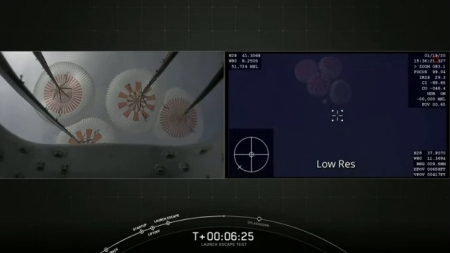SpaceX wins first new launch contract in 2020
Capitalism in space:The Egyptian communcications satellite company Nilsat this week announced that it has awarded SpaceX the launch contract for its next satellite.
This was SpaceX’s first contract award in 2020.
The article goes into great detail about SpaceX’s present launch manifest, which according to the company has contracts for future launches equaling $12 billion.
Based on public info, SpaceX has roughly 55 customer launches on its manifest. The company also intends to launch as many as 24 dedicated Starlink missions this year and will need at least another 40-50 on top of that to complete the first phase of the broadband internet satellite constellation (~4400 spacecraft). Meanwhile, SpaceX has won at least nine separate launch contracts – two Falcon Heavy missions and seven Falcon 9s – in the last 18 months, but has launched 22 customer payloads in the same period.
In fewer words, SpaceX is effectively launching its existing commercial missions much faster than it’s receiving new contracts. In 2019, for example, the company launched only 11 commercial missions – 13 total including two internal 60-satellite Starlink launches. SpaceX launched 21 times in 2018, a record the company initially hoped to equal or even beat last year, but – for the first time ever – the launch company was consistently ready before its customers were.
It appears SpaceX intends to pick up any slack in launch contracts with Starlink satellite launches, which once in orbit are another major income source for the company.
Overall, it seems to me that SpaceX is quite awash with capital, which reinforces their decision to not take government money to develop Starship. Using their own capital they are free to build as they see fit, with no one from the government who knows less than they do looking over their shoulder and kibitzing.
Capitalism in space:The Egyptian communcications satellite company Nilsat this week announced that it has awarded SpaceX the launch contract for its next satellite.
This was SpaceX’s first contract award in 2020.
The article goes into great detail about SpaceX’s present launch manifest, which according to the company has contracts for future launches equaling $12 billion.
Based on public info, SpaceX has roughly 55 customer launches on its manifest. The company also intends to launch as many as 24 dedicated Starlink missions this year and will need at least another 40-50 on top of that to complete the first phase of the broadband internet satellite constellation (~4400 spacecraft). Meanwhile, SpaceX has won at least nine separate launch contracts – two Falcon Heavy missions and seven Falcon 9s – in the last 18 months, but has launched 22 customer payloads in the same period.
In fewer words, SpaceX is effectively launching its existing commercial missions much faster than it’s receiving new contracts. In 2019, for example, the company launched only 11 commercial missions – 13 total including two internal 60-satellite Starlink launches. SpaceX launched 21 times in 2018, a record the company initially hoped to equal or even beat last year, but – for the first time ever – the launch company was consistently ready before its customers were.
It appears SpaceX intends to pick up any slack in launch contracts with Starlink satellite launches, which once in orbit are another major income source for the company.
Overall, it seems to me that SpaceX is quite awash with capital, which reinforces their decision to not take government money to develop Starship. Using their own capital they are free to build as they see fit, with no one from the government who knows less than they do looking over their shoulder and kibitzing.

